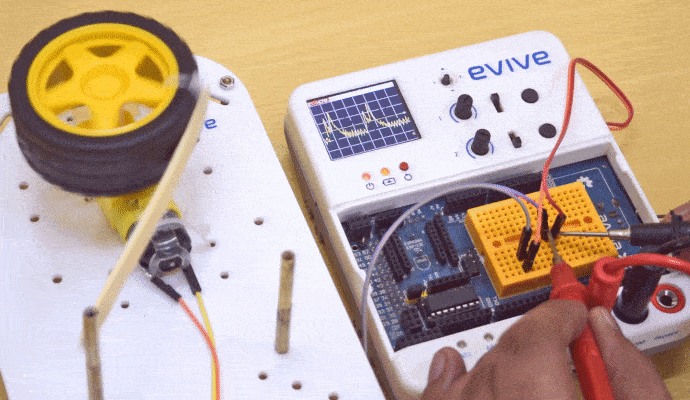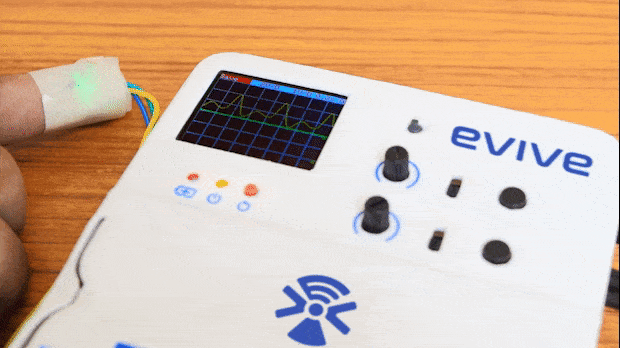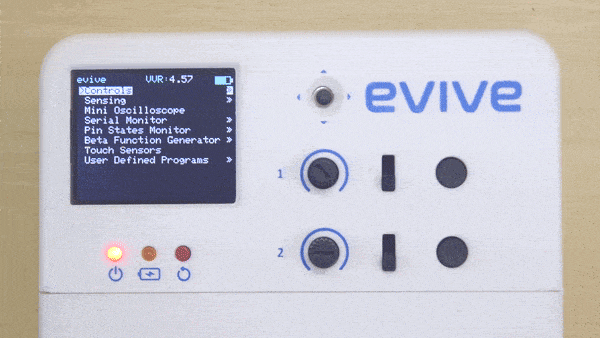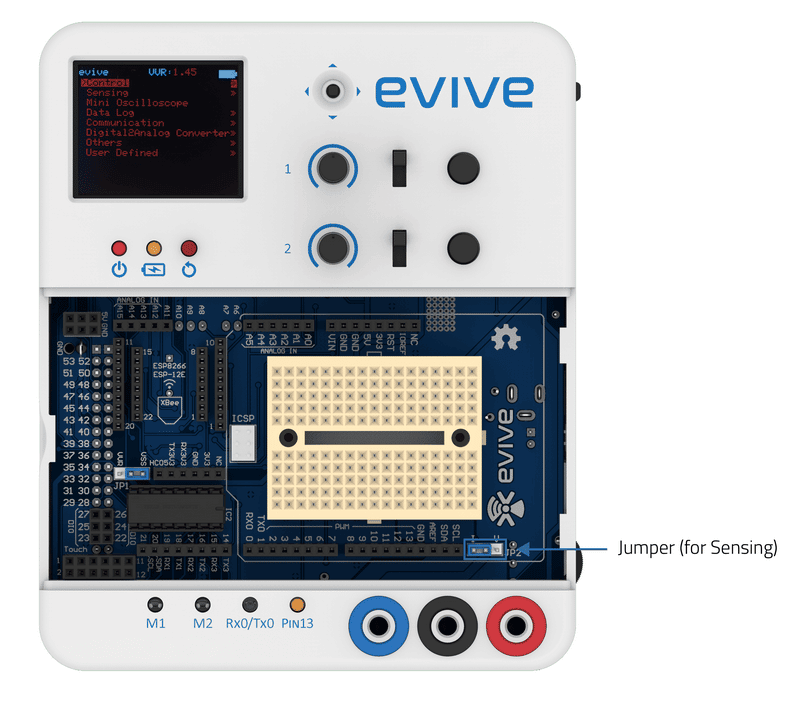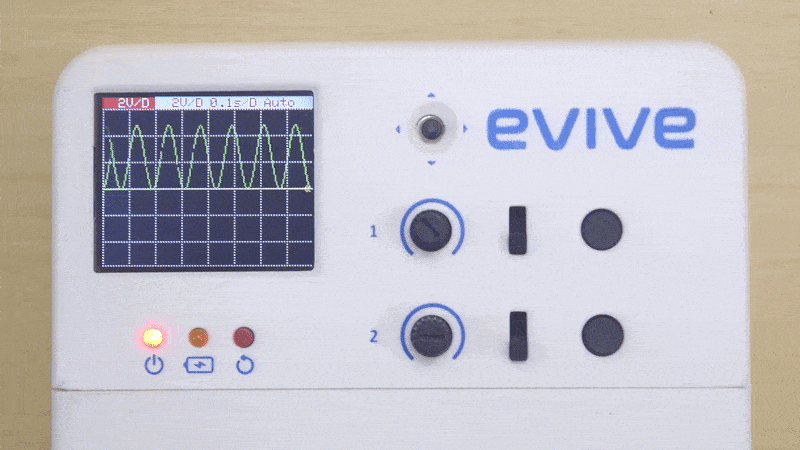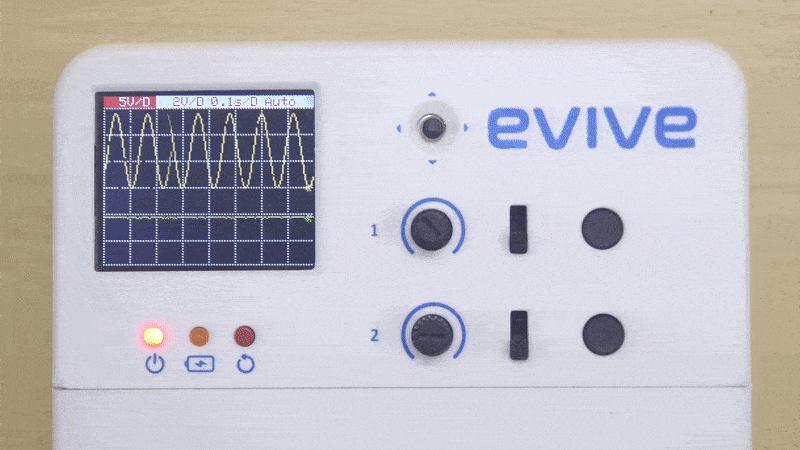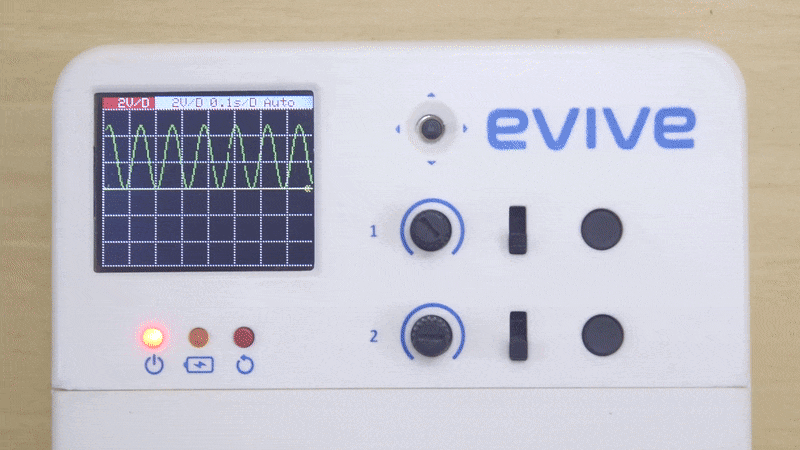Introduction
Note: evive Oscilloscope feature has been discontinued since January 2022.
An oscilloscope is a type of electronic test instrument that allows observation of constantly varying current or voltage signals, usually as a two-dimensional plot of one or more signals as a function of time. Other signals (such as sound or vibration) can be converted to voltages and displayed.
evive Mini Oscilloscope Heat Beat Visualisation
evive has a mini oscilloscope to visualize voltage and current measurements. It has a lot of functions like scaling voltage level, time scaling to see the reading in a better way, a trigger to start the measurement at some set value, scanning modes like single or continuous, offset, save readings to SD card and send data to the computer. It uses a 24-bit dual channel ADC IC (ADE7912)for sensing from Analog Devices.
There are two channels for data acquisition namely Probe I/V and Probe V. The Probe I/V can be used to sense currents or voltage as per the Jumper selection(JP 2 on evive). The maximum sensing frequency is about 1kHz. The current sensing has an accuracy of 3mA with a range of -3A to +3A, while in voltage mode, the accuracy is of 3mV with a range of -5V to +5V. The Probe V can be used for higher voltage sensing in a range of -30V to +30V with an accuracy of 10mV.
Using Mini Oscilloscope
The option for Mini -Oscilloscope appears on the main menu. The ports present at the bottom right of the evive are used for connecting the evive with the circuit in order to use it as an oscilloscope. The three ports present are Channel 1(Probe V), COM, and Channel 2(Probe I/V) from right to left respectively. COM is the reference from which voltage and current is measured.

Channel 1
From channel 1 you can sense voltage between -30V and +30V. Green color signal plotting is for channel 1.
Opening Mini-Oscilloscope Panel and visualizing sin wave signal
Channel 2
From channel 2 you can either sense voltage from -5V to +5V or sense current from -3A to +3A by changing the jumper (JP2). The signal from both these channels is plotted and displayed on the screen. The yellow color is for channel 2.
Sensing the current spikes when the motor is stopped with evive mini Oscilloscope
Voltage divisions
The voltage divisions that can be displayed in evive are:
- 10 V/div
- 5 V/div
- 2 V/div
- 1 V/div
- 0.5 V/div
- 0.2 V/div
- 0.1 V/div
- 50 mV/div
- 20mV/div

Voltage Scaling for Channel 1
Voltage Scaling for Channel 2
The voltage division for each channel can be selected according to the amplitude of the signal.
Time division
The time divisions that can be displayed in evive are:
- 5 ms/div
- 10 ms/div
- 20 ms/div
- 50 ms/div
- 0.1 s/div
- 0.5 s/div
- 1 s/div
- 2.5 s/div
- 5 s/div
- 10 s/div.

Trigger modes
evive has the 4 trigger modes available:
- Auto – This trigger mode allows the oscilloscope to acquire a waveform even when it does not detect a trigger condition. If no trigger condition occurs while the oscilloscope waits for a specific period (as determined by the time-base setting), it will force itself to trigger.
- Normal – The Normal mode allows the oscilloscope to acquire a waveform only when it is triggered. If no trigger occurs, the oscilloscope will not acquire a new waveform, and the previous waveform, if any, will remain on the display.
- Single – The Single mode allows the oscilloscope to acquire one waveform each time you press the RUN button, and the trigger condition is detected.
- Scan – The Scan mode continuously sweeps waveform from left to right.
Offset adjustment
It is used to give a DC offset i.e. displacing the amplitude from the mean position for both Channel 1 & 2.
Voltage Offset for Channel 1
Voltage Offset for Channel 2
Trigger
- Up – The trigger value is considered in the rising part of the graph.
- Down – The trigger value is considered in the falling part of the graph.
The options like Voltage divisions & Offset adjustment are displayed twice for Channel 1 & Channel 2.
Conclusion
In conclusion, evive‘s Mini–Oscilloscope is a powerful tool that can be used to measure voltage and current and visualize them on screen. It has a range of features such as scaling voltage level, time scaling, trigger modes, offsets, save readings to SD card and send data to the computer. It is easy to use and can be used to observe constantly changing current or voltage signals.

